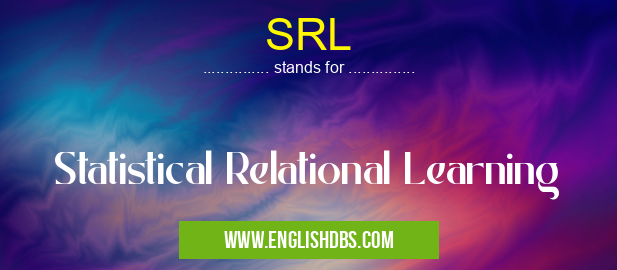What does SRL mean in UNCLASSIFIED
SRL stands for Statistical Relational Learning. It is a field of artificial intelligence research that combines statistical and relational learning techniques to form probabilistic models over structured data, such as knowledge graphs. The primary aim of SRL is to discover complex patterns in the data that are difficult to detect using traditional learning algorithms. SRL also draws upon Bayesian inference approaches, which allow for the combination of uncertain information with known facts in order to make inferences on future events.

SRL meaning in Unclassified in Miscellaneous
SRL mostly used in an acronym Unclassified in Category Miscellaneous that means Statistical Relational Learning
Shorthand: SRL,
Full Form: Statistical Relational Learning
For more information of "Statistical Relational Learning", see the section below.
Essential Questions and Answers on Statistical Relational Learning in "MISCELLANEOUS»UNFILED"
What is Statistical Relational Learning (SRL)?
Statistical Relational Learning (SRL) is an area of machine learning where relational data is used to create a statistical model for making predictions. It combines methods from artificial intelligence, database systems, and statistics, and provides powerful tools for understanding complex relationships between entities in a relational domain.
How does SRL work?
SRL works by combing statistical techniques with methods from artificial intelligence and database systems. It uses the existing relationships between variables in a relational domain and applies them to a given dataset to make predictions or uncover insights about the data.
What are the benefits of using SRL?
The primary benefit of using SRL is its ability to discover patterns and relationships within large datasets that would otherwise be impossible to uncover manually. Additionally, its use of existing data structures makes it highly efficient and scalable for large-scale applications.
What types of algorithms are used in SRL?
Common algorithms used for SRL include Markov logic networks (MLNs), Bayesian logic networks (BLNs), rule-based systems, graphical models, and inductive logic programming (ILP). These algorithms allow for powerful inference over relational data structured into logical forms such as graphs, trees, or rules sets.
How is SRL different from traditional machine learning approaches?
Unlike traditional machine learning approaches which rely on linear models or training data with homogenous features, SRL allows for greater flexibility with regards to the complexity of datasets, as well as more sophisticated inferences about relations among variables. Additionally, SRL can leverage preexisting knowledge bases or taxonomies to provide more accurate results.
What are some applications of SRL?
Applications of SRL can be found in many fields including natural language processing (NLP), recommender systems, fraud detection systems, dynamic pricing systems, bioinformatics, medical diagnosis aids, and robotics control systems. It can also be applied to social network analysis tasks such as link prediction or community detection.
Who uses SRL?
Organizations such as Google have started incorporating elements of statistical relational learning into their products due to its effectiveness at uncovering complex patterns and relationships within datasets. In addition to this commercial use case, academic researchers have also heavily adopted this field due to its wide range of capabilities across various fields including natural language processing (NLP) and computer vision tasks.
Is there any software available for performing Statistical Relational Learning tasks?
Yes! There are several software libraries available that support Statistical Relational Learning tasks including Aleph , CELCT , MLj , ProbLog2 , SAMPLE , ProbCog , EPhysProbCog , PGMiner++ , InFOLearn , ALARM/NeuroSolutions , Gleaner3K . All these libraries include implementations of various algorithms necessary for performing inference over probabilistic graphical models related to relational domains.
How do I get started with Statistical Relational Learning?
To get started relating with Statistical Relational Learning you should first become familiar with concepts such as graphical models(Bayesian Networks/Markov Networks), probabilistic modeling formalisms like first order logic( FOL) & probabilistic logic programming languages like Problog & Markov Logic Network(MLN). Then develop the skills required for applying various mapping methods from the symbolic domain(FOL) onto the graphical one(Graphs & Trees). Finally evaluate existing applications highlighting their strengths & limitations before developing your own application.
Final Words:
In conclusion, Statistical Relational Learning (SRL) is a rapidly growing field in Artificial Intelligence research that combines statistical and relational learning techniques to uncover complex patterns within datasets containing objects and their relations with each other. It uses probabilistic models built on advanced algorithmic techniques such as mathematical optimization algorithms and machine-learning algorithms like neural networks and deep learning to make predictions based on prior known facts about the dataset or the inferred relations among entities within it. This approach has been applied successfully in many areas including automated planning, natural language processing, recommendation systems, medical diagnosis etc., proving its worth compared to traditional machine-learning approaches when dealing with high complexity problems or lacking labeled data points.
SRL also stands for: |
|
| All stands for SRL |
